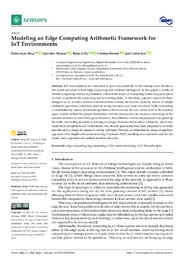Por favor, use este identificador para citar o enlazar este ítem:
https://hdl.handle.net/11000/35621Registro completo de metadatos
| Campo DC | Valor | Lengua/Idioma |
|---|---|---|
| dc.contributor.author | Roig, Pedro Juan | - |
| dc.contributor.author | Alcaraz, Salvador | - |
| dc.contributor.author | Gilly, Katja | - |
| dc.contributor.author | Bernad, Cristina | - |
| dc.contributor.author | Juiz, Carlos | - |
| dc.contributor.other | Departamentos de la UMH::Ingeniería de Computadores | es_ES |
| dc.date.accessioned | 2025-02-12T08:37:24Z | - |
| dc.date.available | 2025-02-12T08:37:24Z | - |
| dc.date.created | 2022-01-30 | - |
| dc.identifier.citation | Sensors 2022, 22(3), 1084 | es_ES |
| dc.identifier.issn | 1424-8220 | - |
| dc.identifier.uri | https://hdl.handle.net/11000/35621 | - |
| dc.description.abstract | IoT environments are forecasted to grow exponentially in the coming years thanks to the recent advances in both edge computing and artificial intelligence. In this paper, a model of remote computing scheme is presented, where three layers of computing nodes are put in place in order to optimize the computing and forwarding tasks. In this sense, a generic layout has been designed so as to easily achieve communications among the diverse layers by means of simple arithmetic operations, which may result in saving resources in all nodes involved. Traffic forwarding is undertaken by means of forwarding tables within network devices, which need to be searched upon in order to find the proper destination, and that process may be resource-consuming as the number of entries in such tables grow. However, the arithmetic framework proposed may speed up the traffic forwarding decisions as relaying on integer divisions and modular arithmetic, which may result more straightforward. Furthermore, two diverse approaches have been proposed to formally describe such a design by means of coding with Spin/Promela, or otherwise, by using an algebraic approach with Algebra of Communicating Processes (ACP), resulting in a explosion state for the former and a specified and verified model in the latter. | es_ES |
| dc.format | application/pdf | es_ES |
| dc.format.extent | 25 | es_ES |
| dc.language.iso | eng | es_ES |
| dc.publisher | MDPI | es_ES |
| dc.rights | info:eu-repo/semantics/openAccess | es_ES |
| dc.rights | Attribution-NonCommercial-NoDerivatives 4.0 Internacional | * |
| dc.rights.uri | http://creativecommons.org/licenses/by-nc-nd/4.0/ | * |
| dc.subject | edge computing | es_ES |
| dc.subject | fog computing | es_ES |
| dc.subject | CNN | es_ES |
| dc.subject | formal modeling | es_ES |
| dc.subject | ACP | es_ES |
| dc.subject | Promela | es_ES |
| dc.subject | Spin | es_ES |
| dc.subject.other | CDU::6 - Ciencias aplicadas::62 - Ingeniería. Tecnología | es_ES |
| dc.title | Modeling an Edge Computing Arithmetic Framework for IoT Environments | es_ES |
| dc.type | info:eu-repo/semantics/article | es_ES |
| dc.relation.publisherversion | https://doi.org/10.3390/s22031084 | es_ES |

Ver/Abrir:
sensors-22-01084.pdf
1,21 MB
Adobe PDF
Compartir:
 La licencia se describe como: Atribución-NonComercial-NoDerivada 4.0 Internacional.
La licencia se describe como: Atribución-NonComercial-NoDerivada 4.0 Internacional.
.png)